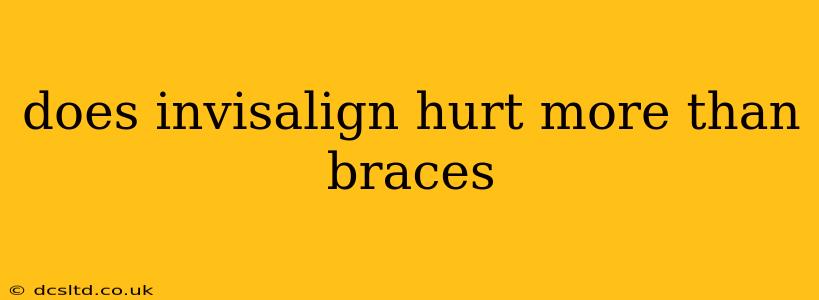The age-old question for orthodontic patients: does Invisalign hurt more than braces? The truth is, the level of discomfort experienced with both Invisalign and traditional braces varies significantly from person to person. There's no single definitive answer, as individual pain tolerance, treatment complexity, and the specific type of appliance used all play a role. However, we can explore the common experiences and factors that contribute to discomfort with both methods.
What Causes Discomfort with Invisalign and Braces?
Both Invisalign and braces work by applying pressure to teeth to gradually shift them into their correct positions. This pressure is the primary source of discomfort for patients.
-
Braces: The brackets and wires of traditional braces can irritate the gums and cheeks, causing sores and discomfort. Tightening appointments often lead to increased pressure and pain for a few days afterward. The metal components can also feel foreign and bulky in the mouth.
-
Invisalign: While Invisalign aligners are made of smooth plastic, they still exert pressure on the teeth to move them. Many patients report initial discomfort and pressure when first placing new aligners. This typically subsides within a few days as the teeth adjust. However, some individuals experience more prolonged or intense discomfort than others.
How Does the Pain Compare? Initial Discomfort
Initial discomfort is often reported as more intense with braces, particularly after tightening appointments. The sharp edges of the brackets and the pressure from the wires can cause significant irritation. Invisalign, on the other hand, usually has a more gradual onset of pressure. The initial discomfort is often described as a feeling of tightness rather than sharp pain.
Ongoing Discomfort Throughout Treatment
Ongoing discomfort is highly variable for both treatments. While the initial pain with braces might be more acute, the consistent pressure and irritation from the brackets and wires can lead to prolonged discomfort for some individuals. With Invisalign, discomfort tends to be episodic, occurring primarily when new aligners are inserted. However, some patients report persistent mild discomfort or soreness, especially during more complex treatment phases.
H3: Does Invisalign cause more sores?
Both Invisalign and braces can cause sores. Brackets are more likely to cause irritation and sores on the cheeks and gums. Invisalign aligners, while smoother, can still rub against soft tissues, particularly during the initial adjustment period. Proper oral hygiene and the use of orthodontic wax can help minimize this risk for both treatments.
H3: Which is more painful, Invisalign or braces, during the adjustment period?
The adjustment period is typically more painful with braces due to the initial placement of brackets and the subsequent tightening appointments. While Invisalign also has an adjustment period with each new set of aligners, the discomfort is usually less severe and shorter-lived.
H3: Is Invisalign better for sensitive teeth?
Patients with sensitive teeth might find Invisalign more comfortable, as the aligners are smoother and less likely to irritate sensitive gums. However, the pressure exerted by the aligners can still cause some sensitivity. It's crucial to discuss your concerns with your orthodontist to determine the best treatment option for your individual needs and sensitivity level.
Factors Influencing Discomfort
Several factors contribute to the level of pain experienced with both treatments:
- Individual pain tolerance: Some people naturally have a higher pain tolerance than others.
- Treatment complexity: More complex cases requiring significant tooth movement may lead to more discomfort.
- Orthodontist's skill: A skilled orthodontist can minimize discomfort through proper appliance placement and adjustments.
- Oral hygiene: Maintaining good oral hygiene is vital to reduce the risk of irritation and infection.
Conclusion
Ultimately, the question of whether Invisalign or braces hurts more is subjective. Both treatments involve some level of discomfort, but the type and intensity of pain vary widely among individuals. The best way to determine which option is right for you is to consult with an experienced orthodontist. They can assess your specific needs, discuss your pain tolerance, and help you choose the treatment method that is most likely to result in comfortable and successful orthodontic treatment. Remember, proper communication with your orthodontist throughout the process is key to managing any discomfort effectively.
